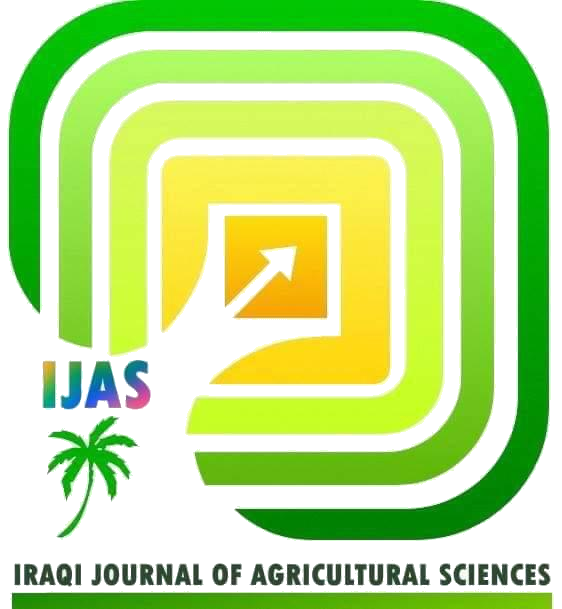PREPARATION, IDENTIFICATION AL (III) AND SELECTIVE ADSORPTION BY IMPRINTING POLYMER IN WATER IN BAGHDAD
DOI:
https://doi.org/10.36103/zyqfqr59Keywords:
isotherm, monomer, langmuir, allyl bromideAbstract
This research aimed to form a molecularly imprinted polymer by adding aluminum ion at the first step were to the allyl bromide monomer resulted was formation using bulk polymerization. To acquire the highest adsorption capacity, molar ratios of template, monomer, and cross-linking agent, as well as solvents and multiple monomers, were investigated. Scanning electron microscopy (SEM) was used to analyze the produced aluminum. the maximum adsorption capacity of Al-IIP were 0.1531 µmol/g and 0.2362 µmol/g respectively. aluminum adsorption followed a Langmuir isotherm model. Solid-phase extraction (SPE) syringe packed with ionic imprinted polymers (IIP) were used to selective separation and preconcentration for aluminum (III) ion from aqueous solutions to determine the aluminum by flame atomic absorption spectroscopy (FAAS).
References
1. Audrey, M, A., and B. Örmeci, 2012. Application of molecularly imprinted and non-imprinted polymers for removal of emerging contaminants in water and wastewater treatment: a review. Environmental Science and Pollution Research, 19, 3820-3830. https://doi.org/10.1007/s11356-012-1119-2
2. Amanda, J. L., R., Yin, and J. L. Jensen, 2001. Molecularly imprinted polymer sensors for pesticide and insecticide detection in water. Analyst, 126(6), 798-802.
DOI https://doi.org/10.1039/B008853F
3. Al-Bayati, Y. K. and Muhamed Farhan Abd, 2017. Determination of methamphetamine drug by GC-MS based on molecularly imprinted solid-Phase used meth acrylic acid and acryl amide as functional monomers, Iraqi Journal of Science, 58: 2022
4. Al-Bayati, Y., and E, Hadi, 2022. Synthesis of new moleculariy imprinted solid phase uesd styeren and allyl chloride base funaction monmer for determination of cocalne by gc-mass and its clinical application. Iraqi Journal of Agricultural Sciences, 53(4): 760-766. : https://doi.org/10.36103/ijas.v53i4.1586
5. Al-Bayati, Y.K. and A.J., Al-Safi, 2018. Synthesis and characterization of a molecularly imprinted polymer for diclofenac sodium using (2-vinylpyridine and 2-hydroxyethyl metha acrylate) as the complexing monomer. baghdad science Journal, 15(1) :62-73
6. Asanuma, H., T., Akiyama, K., Kajiya, T., Hishiya, and M. Komiyama, 2001. Molecular imprinting of cyclodextrin in water for the recognition of nanometer-scaled guests. Analytica Chimica Acta, 435(1), 25-33.
https://doi.org/10.1016/S0003-2670(00)01303-9
7. Alexiadou, D. K., N. C., Maragou, N. S., Thomaidis, G. A., Theodoridis, and M. A. Koupparis, 2008. Molecularly imprinted polymers for bisphenol A for HPLC and SPE from water and milk. Journal of Separation Science, 31(12), 2272-2282. https://doi.org/10.1002/jssc.200700643
8. Fadhel Ibrahem Aljabari and Yaha. K.l Al-Bayati, 2023. Synthesis and characterization of a new sulfamethoxazole -molecularly imprinted Polymer and Using for pharmaceutical application, AIP Conference Proceedings, 2414: 050014.
9. Gupta, N., S.S. Gaurav, and A. Kumar, 2013. Molecular basis of aluminium toxicity in plants: a review. American Journal of Plant Sciences, 4 :9.
10. Hasan N M, A. H. M.and A. M.F, 2016. investigation of the new room temperature ionic liquid of Al (NO3) 3.9 H2O with urea CO (NH2) 2. Baghdad Sci. J, 13(3): 489-497
11. Huang, S.,and et al., 2018. Synthesis and application of magnetic molecularly imprinted polymers in sample preparation. Analytical and Bioanalytical Chemistry, 410(17) : 3991-4014.
12. Huang, W., and et al., 2021. A sensitive electrochemical sensor based on ion imprinted polymers with gold nanoparticles for high selective detecting Cd (II) Ions in real samples. Journal of Inorganic and Organometallic Polymers and Materials, 31(5) : 2043-2053.
13. Ismaeel, S., and Y, Al-Bayati, 2022.determination of trace metformin in pharmaceutical preparation using molecularly imprinted polymer based pvc-membrane, Eurasian Chemical Communications, 3: 812-830.
14. Li, R., and et al., 2001. Advances in molecularly imprinting technology for bioanalytical applications. Sensors, 19(1) : 177.
15. Lai, J. P., R., Niessner, and D. Knopp, 2004. Benzo [a] pyrene imprinted polymers: synthesis, characterization and SPE application in water and coffee samples. Analytica Chimica Acta, 522(2), 137-144. https://doi.org/10.1016/j.aca.2004.07.003
16. Mohsen, H. N., Y. K. Al-Bayati and R. Jalil, 2022. iron ionic imprinted polymers II for separation and preconcentration of iron from Crude and fuel oil. Journal of Petroleum Research and Studies, 35: 27-46.
17. Mohsen, H. N., and Yaha. K.l Al-Bayati, 2021. Synthesis and adsorption characteristics of ionic imprinted polymers IIPs for removal and preconcentration of Nickel from aqueous solution. Egyptian Journal of Chemistry, 64(12): 7001-7010
18. Meng, Z., W., Chen, and A. Mulchandani, 2005. Removal of estrogenic pollutants from contaminated water using molecularly imprinted polymers. Environmental Science & Technology, 39(22), 8958-8962. https://doi.org/10.1021/es0505292
19. Nchoe, O. B., M. J., Klink, F. M., Mtunzi, and V. E, Pakade, 2020. Synthesis, characterization, and application of β-cyclodextrin-based ion-imprinted polymer for selective sequestration of Cr (VI) ions from aqueous media: Kinetics and isotherm studies. Journal of Molecular Liquids, 298: 111991.
20. Rice, E. W., R. B. Baird, A. D. Eaton, and L. S. Clesceri, 2012.Standard Methods For The Examination Of Water And Wastewater. American Public Heal Association Washington, 10 : 3500.
21. Wu, S., and et al., 2022. The ion-imprinted oyster shell material for targeted removal of Cd (II) from aqueous solution. Journal Of Environmental Management, 302 : 114031.
22. Yan, H. and K.H. Row, 2006. Characteristic and synthetic approach of .International Journal of Molecular Sciences, 7(5): 155-178.
23. Yuan, G.,and et al., 2018. A novel ion-imprinted polymer induced by the glycylglycine modified metal-organic framework for the selective removal of Co (II) from aqueous solutions. Chemical Engineering Journal, 333 : 280-288.
24. Yin, J., Z., Meng, M., Du, C., Liu, M., Song, and H. Wang, 2010. Pseudo-template molecularly imprinted polymer for selective screening of trace β-lactam antibiotics in river and tap water. Journal of Chromatography A, 1217(33), 5420-5426. https://doi.org/10.1016/j.chroma.2010.06.044
25. Zhang, H. 2014. Water-compatible molecularly imprinted polymers: Promising synthetic substitutes for biological receptors. Polymer, 55(3), 699-714. https://doi.org/10.1016/j.polymer.2013.12.064
26. Zhao, Z. J., Q., Wang, L., Zhang, and T. Wu, 2008. Structured water and water− polymer interactions in hydrogels of molecularly imprinted polymers. The Journal of Physical Chemistry B, 112(25), 7515-7521. https://doi.org/10.1021/jp800836d
27. Zhu, G., G., Cheng, P., Wang, W., Li, Y., Wang, and J. Fan, 2019. Water compatible imprinted polymer prepared in water for selective solid phase extraction and determination of ciprofloxacin in real samples. Talanta, 200, 307-315. https://doi.org/10.1016/j.talanta.2019.03.070
28. Zheng, X., S., Khaoulani, N., Ktari, M., Lo, A. M., Khalil, C., Zerrouki, and M. M. Chehimi, 2021. Towards clean and safe water: a review on the emerging role of imprinted polymer-based electrochemical sensors. Sensors, 21(13), 4300. https://doi.org/10.3390/s21134300
Downloads
Published
Issue
Section
License
Copyright (c) 2025 IRAQI JOURNAL OF AGRICULTURAL SCIENCES

This work is licensed under a Creative Commons Attribution-NonCommercial 4.0 International License.

2.jpg)


